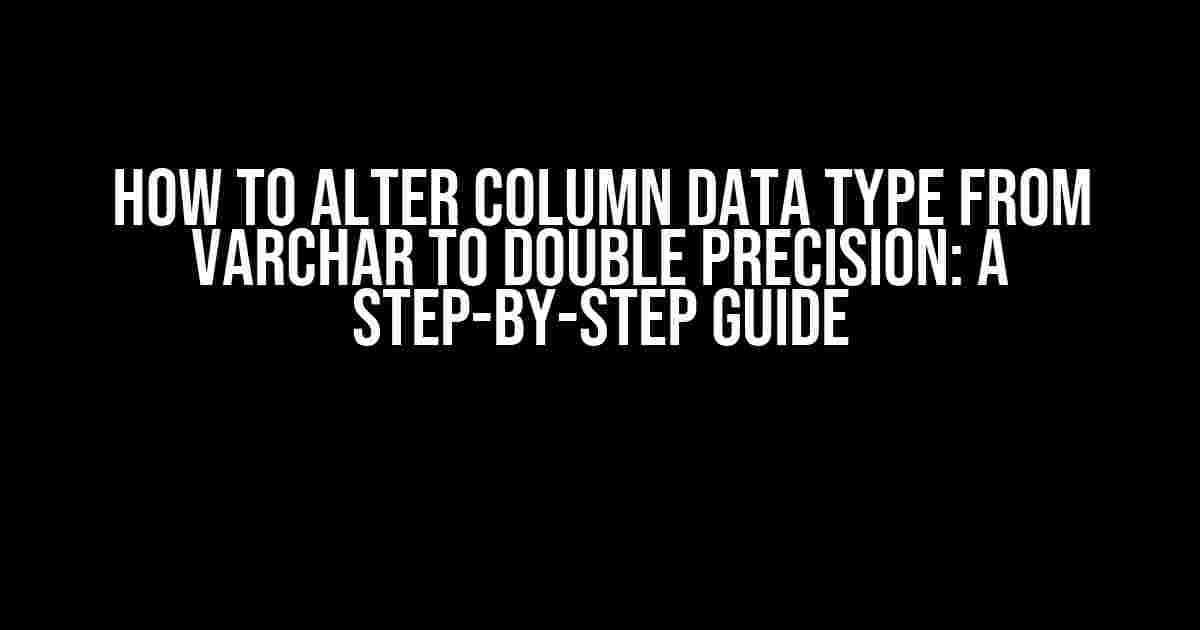The Importance of Accurate Data Types
As a database administrator, you understand the significance of assigning the correct data type to each column in your database. Incorrect data types can lead to data inconsistencies, inefficiencies, and even security vulnerabilities. One common scenario many database administrators face is altering a column’s data type from Varchar to Double Precision. In this article, we will guide you through the process of making this change, ensuring your database remains accurate, efficient, and secure.
Why Alter Column Data Type from Varchar to Double Precision?
There are several reasons why you may need to alter a column’s data type from Varchar to Double Precision:
- Data precision**: Double Precision offers a higher level of precision compared to Varchar, making it ideal for columns that require decimal values.
- Improved performance**: Double Precision is a more efficient data type, leading to improved query performance and reduced storage requirements.
- Enhanced data integrity**: By using Double Precision, you can ensure that decimal values are stored correctly, reducing the risk of data inconsistencies.
Before You Begin: Preparation is Key
Before altering the column data type, it’s essential to take a few precautions to ensure a smooth transition:
- Backup your database**: Create a backup of your database to prevent any data loss in case something goes wrong during the alteration process.
- Check for dependencies**: Identify any dependencies on the column you’re about to alter, such as views, stored procedures, or indexes.
- Test in a development environment**: Perform the alteration in a development environment before applying it to your production database.
The Alteration Process
Now that you’ve prepared your database, it’s time to alter the column data type from Varchar to Double Precision. The exact syntax may vary depending on your database management system (DBMS). For this example, we’ll use PostgreSQL.
ALTER TABLE table_name
ALTER COLUMN column_name TYPE double precision;In this example, replace `table_name` with the name of the table containing the column you want to alter, and `column_name` with the name of the column itself.
Handling Potential Issues
During the alteration process, you may encounter some issues:
- Data truncation**: If the data in the Varchar column exceeds the maximum length allowed by Double Precision, you may lose data. To avoid this, ensure that the data fits within the Double Precision range.
- Conversion errors**: If the data in the Varchar column cannot be converted to Double Precision (e.g., due to non-numeric characters), you may encounter errors. Use the CAST() function to convert the data explicitly.
ALTER TABLE table_name
ALTER COLUMN column_name TYPE double precision
USING CAST(column_name AS double precision);Post-Alteration Tasks
After altering the column data type, perform the following tasks to ensure a smooth transition:
- Update dependencies**: Update any dependencies, such as views, stored procedures, or indexes, to reflect the new data type.
- Test the database**: Verify that the alteration has been successful and that the database is functioning as expected.
- Monitor performance**: Closely monitor database performance to ensure that the alteration has not introduced any bottlenecks.
Conclusion
Altering a column’s data type from Varchar to Double Precision is a straightforward process, but it requires careful planning and execution. By following the steps outlined in this article, you can ensure a successful transition and reap the benefits of improved data integrity, performance, and precision. Remember to prepare your database, handle potential issues, and perform post-alteration tasks to ensure a smooth and successful alteration.
| DBMS | Syntax |
|---|---|
| PostgreSQL | ALTER TABLE table_name ALTER COLUMN column_name TYPE double precision; |
| MySQL | ALTER TABLE table_name MODIFY column_name DOUBLE; |
| Microsoft SQL Server | ALTER TABLE table_name ALTER COLUMN column_name FLOAT(53); |
| Oracle | ALTER TABLE table_name MODIFY column_name DOUBLE PRECISION; |
Remember to consult your DBMS-specific documentation for the exact syntax and any additional requirements.
Frequently Asked Questions
- What if I have a large amount of data in the Varchar column? It’s essential to test the alteration in a development environment before applying it to your production database. This will help you estimate the time required for the alteration and identify any potential issues.
- How do I handle NULL values during the alteration? You can use the COALESCE() function to replace NULL values with a default value, ensuring a smooth transition.
- What if I encounter errors during the alteration? Carefully review the error messages and adjust your syntax accordingly. If necessary, seek assistance from your DBMS-specific community or a database administrator.
By following this comprehensive guide, you’ll be able to successfully alter a column’s data type from Varchar to Double Precision, ensuring your database remains accurate, efficient, and secure.
Here are 5 Questions and Answers about “How to alter column data type from varchar to double precision?” using a creative voice and tone:
Frequently Asked Question
Get ready to dive into the world of database alterations!
Q: Can I directly alter the column data type from varchar to double precision?
A: Ah, if only it were that simple! Unfortunately, you can’t directly alter a column’s data type from varchar to double precision, as it may lead to data loss or corruption. You’ll need to follow a specific process to ensure a smooth transition.
Q: What’s the first step in altering the column data type from varchar to double precision?
A: Step one is to create a new column with the desired data type (double precision) and add it to your table. This will allow you to transfer the data without losing any information.
Q: How do I transfer the data from the old varchar column to the new double precision column?
A: Use an UPDATE statement to transfer the data from the old column to the new one. Be sure to use the CAST() function to convert the varchar values to double precision. For example: UPDATE mytable SET new_column = CAST(old_column AS double precision).
Q: What’s the final step in altering the column data type from varchar to double precision?
A: Once you’ve transferred all the data, drop the old varchar column to avoid any confusion or data inconsistencies. Voilà! Your column is now altered to double precision.
Q: Are there any potential issues I should watch out for when altering the column data type?
A: Yes! Be cautious of potential issues like data truncation, precision loss, or errors when converting data. Make sure to test your data thoroughly and backup your database before making any changes.


